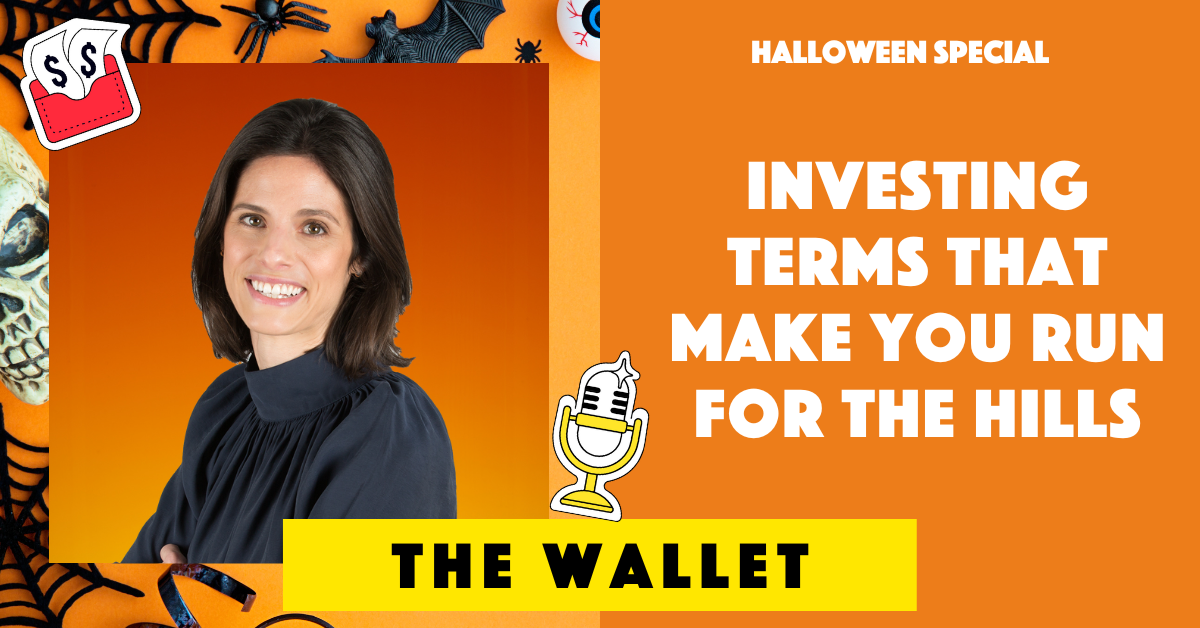Halloween Special: Investing Terms that Make You Run For the Hills
🎃 Let’s face it: one of the most common reasons we hear about why someone isn’t investing is because it all seems a bit ‘scary’. On top of it all, the market has been quite frightening to watch in recent months, even the most seasoned investor would get the creeps! So what can we do about this fear?
On today’s episode, we unpack some of the freakiest financial jargon and the key issues that tend to scare new investors.
***
You can listen (17 min) and subscribe here:
***
Investing is scary…
You want to invest, but you are too scared — scared to lose money, you don’t understand the financial lingo — but also, what if you get scammed? We are usually scared of what we don’t know or don’t understand, so let’s address the main issues that tend to scare new investors.
Fear of Losing Money
Different investment vehicles with different expected returns: they are listed from the safest to the riskier. We included an expected annual return (EAR) that will help us to benchmark these investments. It has been calculated by looking at the annual return in these different products over a reasonable long horizon. These are not guaranteed and should be treated as indicationsm, since they may differ greatly depending on the details of the investment. In addition, since past performance is not an indication of future performance, please consider these as a tool to better understand your investment options.
- 4% in money markets: short-term debt – under 2 years of maturity – usually issued and guaranteed by banks.
- 5-6% on government bonds: government guaranteed debt maturing between 5 to 30 years paying an annual coupon and returning your initial investment at maturity.
- 7% on high grade bonds: bonds issued by companies with a superior credit rating i.e. in solid financial health.
- 10% on equities: from top indices S&P, FTSE, CAC, DAX, etc…: equities issued by the largest companies of a national economy.
- 12% on high yield bonds: bonds issued by companies with an inferior credit rating i.e. in precarious financial health.
- 13% on small capitalisation equities: shares issued by the smallest companies of a national economy in terms of market capitalisation or size. The idea is simple, the smaller the company the less diversified it is and therefore the more likely it is to be impacted by an external shock. Therefore, investors expect higher returns compared to larger companies since the perceived risk is higher.
- 15% on Real estate: property consisting of land or buildings.
- 30% on Venture capital: first we had large cap, then small cap and now venture capital. In this case there is a substantial element of risk since you invest at the earliest stage of the company where growth is usually put before profits, typically a new or expanding business.
- 100% on cryptocurrencies: a digital currency or asset in which transactions are verified and records maintained by a decentralized system using cryptography, rather than by a centralized authority.
Now let’s turn to the investment horizon: when will you need the money?
Short term (<1 year): vacations, durable goods (laptop, phone, clothes, …), emergency fund
Medium term (5 years): deposit for mortgage, a car
Long term (10 years): education, junior ISA, buy a secondary home
Ultra-long term (30 years): pension, retirement,
scary language
Management fees / trading cost: when you trade a single stock, you will only be charge a small fee to sell buy the exchange. The investment platform may also charge you an annual fee to “keep” your investment. You could see that as the cost of hiring a safe in a bank to store your cash or some gold bars! While, when you trade an ETF or an Index, you will be charged an annual management fee in addition to a trading. The management fee accounts for the rebalancing of the index. Each time a company falls out or enters the index, the manager will need to rebalance and will charge you for it. Look out for fees before you buy any investments.
Compound interest: We mentioned this one several times, and we will borrow an example from nature to understand it best. When a tree releases seeds which will sprout and grow into adult trees. These trees will in turn release seeds, which will themselves become trees. With time, a tree will turn into a forest! Getting back to finance, the higher the interest you earn on an investment (i.e., the more seeds), or the appreciation of your capital, the more money you will have in the future. What is important to note here is that just like it takes centuries to grow a forest, it takes time for compound interest to work out its full potential.
Assets: anything that you own and has value or is expected to have value in the future.
P/E ratio: Price to earning ratio. This is one of the most basic valuation metrics for stocks. When investors look at the entire universe of stocks, they need to find a way to compare them. For instance, how do you compare the 100 stocks in the FTSE 100? Analysts came up with this ratio where you compare 1 unit price versus 1 unit of earning. This allows them to understand if a company is more or less expensive than before, and if a company looks cheap or expansive vs its peers (a company in the same sector). If the P/E ratio is unchanged, it means the price of the company grows at the same pace as its earnings. If the P/E ratio increases, it means either the stock price appreciated relative to earnings or earning decreased relative to its price.
Portfolio: the sum of your investments. This may include your house, your savings account, etc.
Index and ETF: Did you know the main stock indices can’t be bought or sold? Indeed, you need to go through providers who will replicate the index for you in a tradable format. For instance, the FTSE 100 is the index of the 100 largest UK companies. It serves as a gauge of the UK economy, and it is only an index. The history of index funds goes back to mid 70s when passive investing grew in popularity thanks to low fees translating in higher performance. It started with the main indices and grew into a real business where we created indexes for for pretty much anything: exposure to a country or a region (Brazil or Latin America), small or large companies, to a sector in the economy (oil industry, 3D printing) etc. Asset managers do all the buying and selling on your behalf in exchange for a fee. That is the fee you need to watch out for when investing in an index. This fee will “eat your returns” and weight on the compounding effect of your investment. ETF and indices are the same, only ETFs can be bought or sold through the market opening hours, while indexes are only bought or sold at a given price at the end of the day.
Volatility: That is a scary one! We tend to associate volatility with panic, since market tend to move around more when there is some uncertainty or fear! Volatility is another measure analysts use to compare assets. It measures how much an asset moves over a certain period. The more it moves, the more potential returns investor require buying an asset. We should use volatile periods as an opportunity to either take some partial profit if an investment has done extremely well in a short period of time, or add to a position if it has underperformed. We should embrace volatility!
beware of spooky scams
Scammers are getting smarter. Be ultra-cautious where you invest your money. Ask around you which platform your friend or family use? Why they like it? How much they charge? Some offer investment research, which can be interesting if you want to develop your investors skills. Then do some research on them. If something doesn’t sound right, get to the bottom of it before transferring your savings.
When it’s too good to be true, well it’s not true. Many will try to lure you when you join with gifts or cash back. Platforms know that once you joined, it is very unlikely you’ll switch to another provider. Therefore, it is common to see investment platform offering £50 - £100 in cash or presents to new clients. Anything too generous must ring alarm bells. This is especially true in the world of cryptocurrency. You will never give your money to some stranger in the street. It should be the same with investment platform, get to know them before you trust them with your money.
Generally: Never click on links, always go straight to companies’ website.
*** #ad Sponsored by Chase, a digital bank that makes every day rewarding. Get 1% cashback on your everyday debit card spending, 24/7 customer support, and a numberless debit card to help keep your details safe. Download the free Chase app today. 18+, UK residents. Cashback exceptions apply.***

